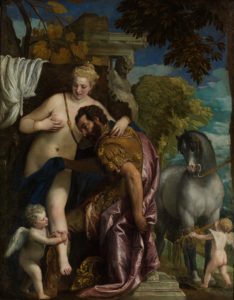Extraordinarily, despite his ongoing popularity (tesitified by the amount of his work in the National Gallery’s own collection), there has never yet been a monographic show on Paolo Veronese in England. This is a striking omission that has been handsomely corrected in the National Gallery Exhibition, which ran from 19 March until 15 June 2014. I use the word handsomely advisedly as several of the Gallery’s upstairs rooms have been re-decorated especially for the exhibition, and the paintings sit very well on the grey and red chosen. Nor are the paintings too crowded, as they often are in modern exhibitions, so proper study can take place, while the labelling has been removed to the free booklet. This also contains a map of Venice which is a brilliant stroke for giving context to the works on display. Finally the audience’s eye is cleverly and continually drawn from one room to the next by the hanging of the works. Above all the use of the upstairs galleries allows natural light to flood in and, particularly on a sunny day, the light of the Veneto is brought in—the effect is quite extraordinary.


Enough on the setting though. The immediate impression, for all that one thinks one knows Veronese, is it is not until one has seen own his work en masse that one can appreciate the true scale of his talent. Too often museum’s label paintings as by Veronese himself, when they are in fact a workshop product. More than just Titian’s heir, through this exhibition Veronese is shown to be a towering artist in his own right. And in areas that one does not necessarily expect either, the large scale religious works are well known, but not so much his portrait work. The lay out follows a logical chronological path that allows the audience to track the development of the artist’s career. Veronese, from Verona, was already a precocious genius when he moved to Venice at the age of about 28 as the very first room make clear. His reputation was such that he had been commissioned to paint an altarpiece for Mantua as early as 1552—one of a number of remarkable loans. While the Louvre ‘Supper at Emmaus’ reveals both his skill as a portraitist and his consummate handling of colour.
Through a small room containing three of his finest portraits, the third and fourth rooms are the highlight of the exhibition and showcase Veronese’s role as the painter of choice for Venice’s churches and palaces in the scond half of the sixteenth century. Those qualities for which he is most famous, his sense of colour and his appreciation of the dramatic, are displayed vividly here through a choice selection of works. The stand out works are the ‘Martyrdom of Saint George’ from Verona and the National Gallery’s own ‘Family of Darius’ in the fourth room. The sheer scale of these works at first overawes the viewer before he is drawn in to the drama of the subjects depicted. The succeeding rooms though show how, by contrast, Veronese’s later works are remarkable for their unexpectedly dark palette, and he often chooses night scenes. This exhibition also reveals many facets of his art with which a modern audience is unfamiliar; the small ‘Venus, Mars and Cupid’ or the ‘Lucretia’ for example have a moving pathos.
This exhibition represents a fitting culmination, as the curator Xavier F Salomon, now at the Frick, has been working on the artist for a number of years now, he was also responsible for the magnificent exhibition at Dulwich Picture Gallery in 2009. My only disappointment if that this show left me wanting more, there are in fact only some fifty paintings on display. The range and quality of the loans is extraordinary but given that much of the work is in fresco in churches and villas it was unobtainable. The only solution, and what the exhibition encourages, is a visit to Venice itself.
Piers Baker-Bates
